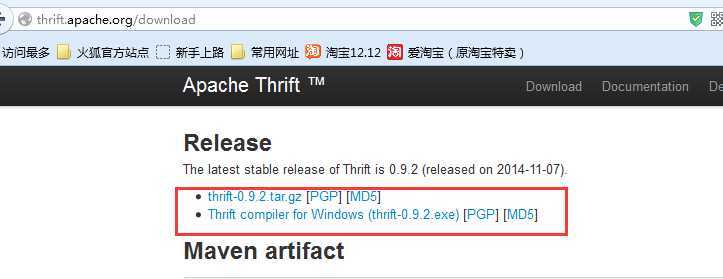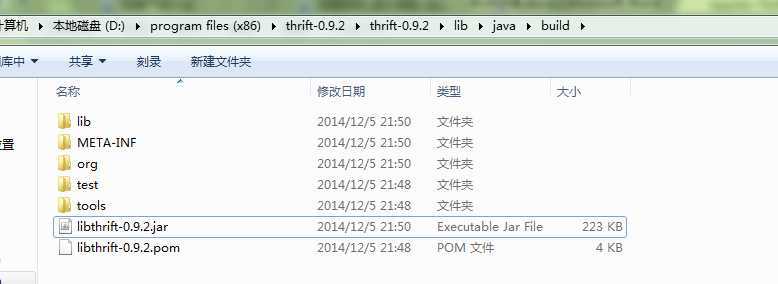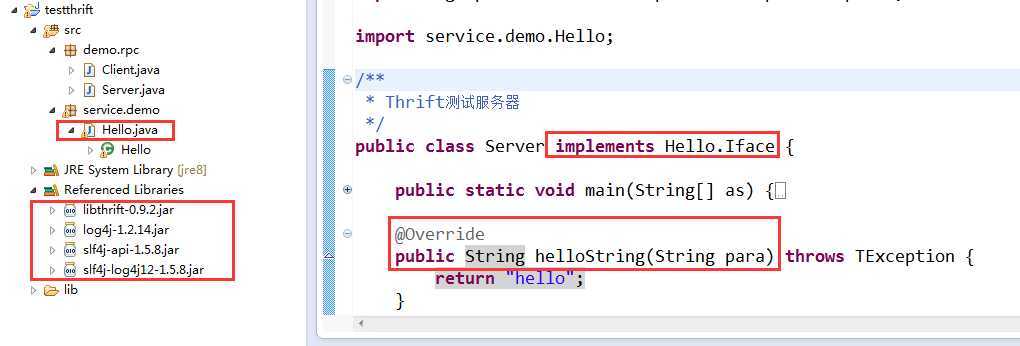标签:blog http io ar os 使用 sp for java
Apache thrift是 Facebook 实现的一种高效的、支持多种编程语言的远程服务调用的框架。
它采用接口描述语言定义并创建服务,支持可扩展的跨语言服务开发,所包含的代码生成引擎可以在多种语言中,如 C++, Java, Python, PHP, Ruby, Erlang, Perl, Haskell, C#, Cocoa, Smalltalk 等创建高效的、无缝的服务,其传输数据采用二进制格式,相对 XML 和 JSON 体积更小,对于高并发、大数据量和多语言的环境更有优势。
配置第一个thrift实例:
1、 去thrift官网 http://thrift.apache.org/tutorial/ 下载thrift压缩包和thrift编译工具thrift.exe.如图所示:
2、 安装ant和maven工具,去官网下载并配置环境变量即可。然后进入/lib/java目录下使用ant编译build.xml,(就是执行ant build.xml,当然注意路径)可以生成libthrift-0.9.2.jar,如图所示。
3、 编译一个简单的hello服务:新建文件改名为hello.thrift(注意更改后缀名)内容如下:
namespace java service.demo
service Hello{
string helloString(1:string para)
}
Thrif文件中为服务定义了方法的接口其中包括返回值类型和参数列表,参数列表中包括参数序号、参数名和参数类型。
4、Thrift 脚本可定义的数据类型包括以下几种类型:
5、进入thrift.exe所在目录执行thrift-0.9.2.exe –gen java hello.thrift 编译刚才写的thrift脚本就可以得到一个hello.java 文件。
6、用Java做服务器端和客户端测试服务的发布:
建立一个Java项目,将生成的hello.java 引入项目中,引入libthrift-0.9.2-snapshot.jar(第二步用ant工具编译生成的)、slf4j-api-1.5.8.jar、slf4j-log4j12-1.5.8.jar 和 log4j-1.2.14.jar四个jar包。项目如下图:
然后编写接口的实现类,服务端,客户端。
7、这里为了方便将服务器端代码和实现类写在了一起
服务器端:
package demo.rpc;
import org.apache.thrift.TException;
import org.apache.thrift.protocol.TBinaryProtocol;
import org.apache.thrift.protocol.TBinaryProtocol.Factory;
import org.apache.thrift.server.TNonblockingServer;
import org.apache.thrift.server.TServer;
import org.apache.thrift.transport.TNonblockingServerSocket;
import org.apache.thrift.transport.TNonblockingServerTransport;
import org.apache.thrift.transport.TTransportException;
import service.demo.Hello;
/**
* Thrift测试服务器
*/
public class Server implements Hello.Iface {
public static void main(String[] as) {
TNonblockingServerTransport serverTransport = null;
try {
serverTransport = new TNonblockingServerSocket(19090);
} catch (TTransportException e) {
e.printStackTrace();
}
//Server 为Hello接口的实现类
Hello.Processor<Hello.Iface> processor = new Hello.Processor<Hello.Iface>(
new Server());
Factory protFactory = new TBinaryProtocol.Factory(true, true);
TNonblockingServer.Args args = new TNonblockingServer.Args(
serverTransport);
args.processor(processor);
args.protocolFactory(protFactory);
TServer server = new TNonblockingServer(args);
System.out.println("Start server on port 19090 ...");
server.serve();
}
@Override
public String helloString(String para) throws TException {
return "hello";
}
}
客户端代码如下:package demo.rpc;
import org.apache.thrift.TException;
import org.apache.thrift.protocol.TBinaryProtocol;
import org.apache.thrift.transport.TFramedTransport;
import org.apache.thrift.transport.TSocket;
import org.apache.thrift.transport.TTransport;
import service.demo.Hello;
/**
* Thrift测试客户端
*/
public class Client {
public static void main(String[] args) {
long startTime = System.currentTimeMillis();
try {
TTransport transport = new TFramedTransport(new TSocket(
"localhost", 19090));
TBinaryProtocol protocol = new TBinaryProtocol(transport);
// TCompactProtocol protocol = new TCompactProtocol(transport);
Hello.Client client = new Hello.Client(protocol);
transport.open();
for (int i = 0; i < 1000; i++) {
System.out.println(client.helloString("login"));
}
transport.close();
} catch (TException x) {
x.printStackTrace();
}
long endTime = System.currentTimeMillis();
System.out.println(" 本次调用完成时间:" + (endTime - startTime));
}
}
8、启动服务器端,再运行客户端。控制台打印循环调用1000次服务所用时间。
标签:blog http io ar os 使用 sp for java
原文地址:http://www.cnblogs.com/xucheng/p/4154243.html